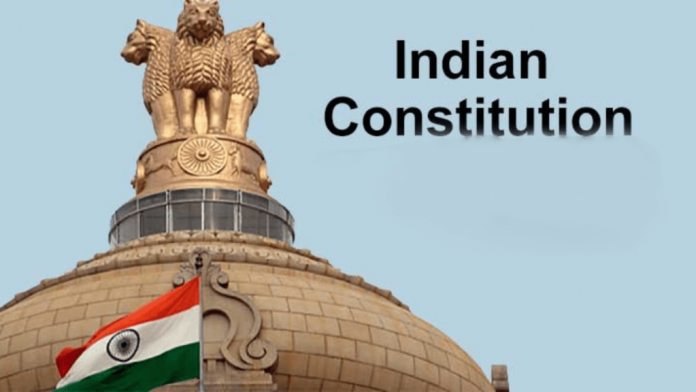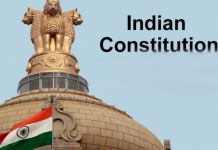This article is written by Vivek Maurya from ICFAI Law University, Dehradun. This article describes the constitutional provision which determines delimitation.
Table of Contents
Introduction
The Central Government appoints a Delimitation Commission to delineate the borders of Parliamentary Constituencies in accordance with the requirements of the Delimitation Act, 2002. The current constituency delimitation was completed under the terms of the Delimitation Act, 2002, using 2001 census data. Despite the foregoing, the Indian Constitution was explicitly modified in 2002 to prohibit constituency delimitation until the first census after 2026. As a result, the current constituencies established based on the 2001 census will remain in effect until the first census after 2026.
Delimitation
Meaning
The process of drafting or redrawing the borders of parliamentary or assembly seats is referred to as delimitation. The procedure is repeated every few years to guarantee that each constituency has an equal number of voters, with the underlying reasoning being that each constituency has one representative in both the Lok Sabha and the state assembly across the nation. As a result, the exercise is performed after each census.
Delimitation creates a link between an increase in the population of a state and an increase in the number of elected legislators in that state. It guarantees that no delegates are “overrepresented” or “underrepresented.” It equalises the votes of the electorate by balancing the constituencies based on the strength of the electorate. Delimitation aims to preserve a “population seat ratio” across the Union or Federation, as well as across various constituencies within each State. In the Indian context, this justifies reserving seats for SCs and STs as well. The philosophical goal for the entire process is the notion of “one man, one vote, one value”.
Delimitation is a practice that has to be done regularly. Though the population continues to rise steadily, the impact of this is seen after a while, in the form of disproportionate population growth in various states and districts. As a result, delimitation is needed to balance the population in different States and constituencies at specified predetermined intervals. Most nations that consider delimitation to be a definite democratic activity do so regularly.
The Delimitation Act, 2002
The redrawing of the boundaries of an assembly or Lok Sabha constituency is known as delimitation. It’s done to reflect changes in the population of a state, a union territory, or the entire country. Delimitation is the process of allocating a set number of seats in a state legislature or the Lok Sabha to members of the Scheduled Caste and Scheduled Tribe communities. Thus, Parliament has enacted a Delimitation Act under Article 82 of the Constitution following each census. Following that, the Delimitation Commission, a high-powered organisation, is formed to carry out the process of demarcating constituency borders. The Commission’s decisions are legally binding and cannot be challenged in a court of law. An order made by the Commission cannot be changed by anybody; not even by the Parliament.
A retired or serving Supreme Court judge serves as the head of the Commission. The Chief Election Commissioner or one of the two election commissioners, as well as the election commissioner for the state where the election is taking place. In addition, associate members of the Commission are chosen from among the state’s five MPs and MLAs.
The Commission relies on the Election Commission workers to carry out the lengthy procedure because it is a transitory body with no full-time staff. Census data is collected for each district, tehsil, and gram panchayat, and new borders are drawn. It might take up to five years to complete the task. The Commission’s major responsibilities are to :
- Appropriate distribution of seats in the national legislature (Lower House) across numerous states or provinces, large or small, while preserving as much as possible, the seat-to-population ratio in most, if not all, of the states or provinces.
- Drawing or redrawing the electoral borders of the states or provinces such that there are as many electoral districts of similar size and population as the number of elected MPs of the national legislature assigned to the individual states or provinces.
- Drawing or rearranging the electoral boundaries of each State or province in such a way that there are as many electoral districts of similar size and population as the number of elected representatives to the lower house of each State or province’s Legislative Assembly.
Delimitation provision in the Indian Constitution
According to Section 8 of the Delimitation Act, 2002, the Commission will readjust the number of seats or delimitation in accordance with the following provision of the Indian Constitution:
Article 81 – Composition of the House of the People
Article 81 of the Constitution, as it existed before the Constitution (Forty-second Amendment) Act of 1976. The Lok Sabha was supposed to have not more than 550 members. Clause (2) of Article 81 stipulated that, for the purposes of sub-clause (a) of clause (1), a number of seats in the House of People are assigned to each State in such a way that the ratio between that number and the population of the State be, as far as feasible, the same for all States. Furthermore, clause (3) defines the term “population”, for the purposes of Article 81, to mean the population as determined at the most recent previous census, the results of which have been published.
As a result of this mandate, states that took the lead in population reduction faced the potential of losing seats, whilst those with larger population statistics stood to gain by increasing the number of Lok Sabha seats. To assuage these fears, Section 15 of the Constitution (Forty-second Amendment) Act of 1976 imposed a freeze on the population figure based on the 1971 Census as 54.81 crores, with a registered electorate of 27.4 crores for the purposes of the proviso to Article 81(3)(i), until the relevant figures for the first census taken after the year 2000 were published. The deadline was extended from 2000 to 2026 under Section 3 of the Constitution (Eighty-fourth Amendment) Act 2001.
Article 82 – readjustment after each census upon the completion of each census
After each census, the Parliament enacts a Delimitation Act under Article 82 of the Constitution. The Central Government established a Delimitation Commission once the Act came into effect.
The Indian Constitution was expressly changed in 2002 to postpone constituency delimitation until the first census after 2026. As a result, the current Constituencies, which were created based on the 2001 census, will continue to exist until the first census after 2026. The President of India appoints the Delimitation Commission, which collaborates with the Election Commission of India. retired Supreme Court Judges, Chief Election Commissioners, and Respective State Election Commissioners make up the Committee.
Article 170 – composition of the legislative assemblies
According to Article 170, a state’s Legislative Assembly must have a minimum of 60 members and a maximum of 500. In addition, if the Governor of the State determines that the community requires representation, he may select one Anglo-Indian to represent it. Direct election from territorial constituencies selects the elected members. The size of the population as determined by the most recent census statistics has been indicated as the foundation for constituency delimitation and seat distribution. The basic idea of proportionality of representation and one person, one vote is established in the article. Even though mathematical precision in proportional representation was not intended or feasible, the provisions added in Article 170 as in Article 82 have effectively made the primary provision and its concept useless. It’s possible that this is being done only for political reasons and electoral limitations. As a result, it’s impossible to support it on any other legal or non-legal basis.
The Constitution (Seventh Amendment) Act of 1956 modified this Article. The scale of representation was omitted because it was thought that there might be States with populations of less than 4.5 million, in which case the two conditions of a minimum of 60 members and a scale of representation of not more than one member for every 750,000 people couldn’t be met at the same time. It was stipulated that the highest number of members would be 500 and the minimum would be 60 and each state would be divided into territorial constituencies. The population to the number of states ratio in each constituency would be the same throughout the State and each constituency will be the same throughout the State. The provision for constituency adjustments following each decennial census was kept.
Article 330 – reservation of seats in the House of People for Scheduled Castes and Scheduled Tribes
Article 330 of the Constitution of India, read with Section 3 of the R. P. Act, 1950, provides for the allocation of seats for Scheduled Castes and Tribes in the Lok Sabha based on the proportion of Scheduled Castes and Tribes in the State concerned to the total population.
Article 332 – reservation of seats for Scheduled Castes and Scheduled Tribes in the Legislative Assemblies of the States
The Constitution (Fifty-first Amendment) Act, 1984 was passed to allow for reservation of seats for Scheduled Tribes in the House of People in Nagaland, Meghalaya, Mizoram, and Arunachal Pradesh, as well as in the Legislative Assemblies of Nagaland and Meghalaya, by modifying provisions under Article 332. Even though these States are predominantly tribal areas, the underlying goal of the aforementioned Article was to ensure that the members of the Scheduled Tribes in these areas were not denied even a minimal level of representation due to their inability to compete with the more advanced sections of the population.
Important Judgements
Meghraj Kothari v. Delimitation Commission and others, 1996
The petition was dismissed summarily by the Madhya Pradesh High Court under Article 226 of the Constitution, which sought a writ of certiorari to quash a notification issued in accordance with subsection (1) of Section 10 of the Delimitation Commission Act, 1962 in respect of the delimitation of certain Parliamentary and Assembly constituencies in the state of Madhya Pradesh. The petition was denied on the simple grounds that the notification could not be challenged in any court under Article 329(A) of the Constitution.
Association of Residents of Mhow (ROM) & Another v. The Delimitation Commission of India & Others, 2009
In this case, the Commission finally determined the delimitation of parliamentary constituencies in the state of Madhya Pradesh after taking into account all objections and suggestions received before the deadline and publishing its order in the Gazette of India and the official Gazette of the state, as required by Section 10(1) of the Act. The order placed them on the same street as legislation enacted by parliament. As a result, the notice must be considered as law and provided to.
Atma Singh And Others vs. State Of Punjab And Others, 2014
The writ petition was properly used by the voter to challenge the legality of the Delimitation of Constituencies notifications issued under Section 5(5) of the Act, and the Mandal Panchayat elections held pursuant thereto, according to the primary decision relied on by the learned single judge.
Conclusion
India is one of the world’s largest democracies and a key representation of democracy. The term “representation” in this context refers to standing in for someone else or working on their behalf. We all assess representation in the modern world by how elections are held in that country. While other democratic nations have chosen proportional representation, India has chosen territorial representation. As a result, the country is split into several constituencies for this purpose.
Now, if we want the country’s technique of representation to be faultless at the international level, we must ensure that it is flawless. It should not be the one in which the wordings are completely dissimilar to the real workings. And it is critical for this reason that the delimitation process not be placed in the hands of the general people, but rather in the hands of those whose votes matter and who can confidently figure out how to make each vote count.
References
- https://www.epw.in/journal/2006/09/perspectives/delimitation-india.html
- https://www.jstor.org/stable/42753697?read-now=1&refreqid=excelsior%3A1ed08b1f627744defa11e6bab4799c5e&seq=5#page_scan_tab_contents
- https://lexlife.in/2020/06/20/explained-delimitation-act/
Students of Lawsikho courses regularly produce writing assignments and work on practical exercises as a part of their coursework and develop themselves in real-life practical skills.
LawSikho has created a telegram group for exchanging legal knowledge, referrals, and various opportunities. You can click on this link and join:
https://t.me/joinchat/J_0YrBa4IBSHdpuTfQO_sA
Follow us on Instagram and subscribe to our YouTube channel for more amazing legal content.











